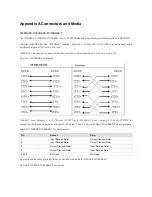
·
Chapter 2 Preparing for Installation
To prevent device damage and bodily injury, please read carefully the safety recommendations described in
this chapter.
The recommendations do not cover all possible hazardous situations.
Installation Safety
Do not expose the AP to high temperature, dusts, or harmful gases.
Do not install the AP in an inflammable or explosive environment.
Keep the AP away from EMI sources such as large radar stations, radio stations, and substations.
Do not subject the AP to unstable voltage, vibration, and noises.
Keep the AP at least 500 meters away from the seaside and do not face it toward the wind from the sea.
The installation site should be free from water flooding, seepage, dripping, or condensation.
The installation site shall be selected according to network planning and features of communications equipment, and
considerations such as climate, hydrology, geology, earthquake, electric power, and transportation.
Temperature and Humidity
To ensure normal operation and service life of the device, maintain appropriate temperature and humidity levels in your
equipment room.
Operating Temperature: -10ºC to 45ºC
Storage Temperature: -40ºC to 70ºC
Operating Humidity: 5% to 95%RH (non-condensing)
Cleanness
Dust poses a serious threat to device operation. Dust that falls onto the surface of the device can be absorbed onto metal
contact points by static electricity, resulting in poor contact. Electrostatic absorption of dust occurs more easily when the
relative humidity is low, which may shorten the service life of the device and cause communication failures. Table 2-1
shows the maximum concentration and diameter of dust allowed in the equipment room.
Table 2-1 Maximum Concentration and Diameter of Dust Allowed





































